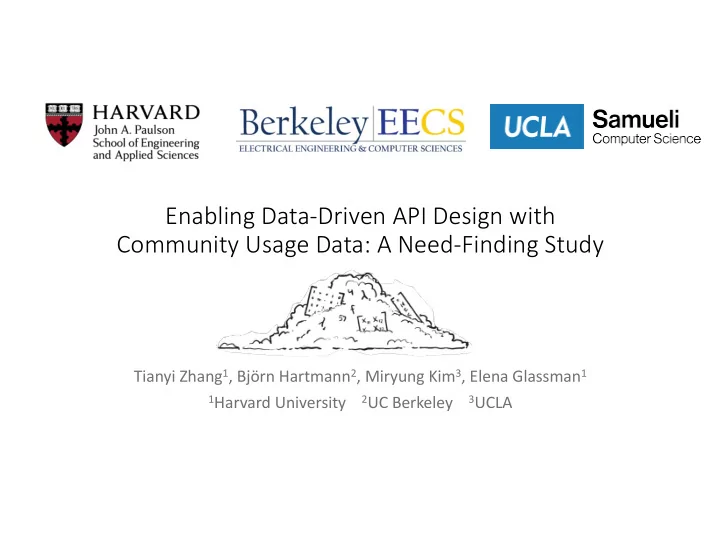

Enabling Data-Driven API Design with Community Usage Data: A Need-Finding Study Tianyi Zhang 1 , Björn Hartmann 2 , Miryung Kim 3 , Elena Glassman 1 1 Harvard University 2 UC Berkeley 3 UCLA
APIs are ubiquitous Frameworks SDKs Web APIs & libraries …
APIs are a primary interface between programmers and computers APIs Programmer Computer
Human-Centered API Design • Apply HCI methods to API design, e.g., A/B testing [1,2,3] • But it is costly. • Too many APIs and usage scenarios • Participant recruitment 1. Ellis et al. The factory pattern in API design: A usability evaluation. ICSE 2007 2. Stylos et al. A case study of API design for improved usability. VL/HCC 2008. 3. Stylos et al. The implications of method placement on API learnability. FSE 2008.
A lot of API usage data has been generated from programmer communities…
How can we le leverage communit ity data to in inform better API desig ign?
Contributions • Semi-structured interviews with 23 API designers • An in-depth analysis of their design styles, usability evaluation methods in practice, and unmet information needs • Several tool design implications for leveraging community API usage data to inform API design
Interview with 23 API Designers 2 10 11 Large Tech Companies Academia Open-source 6 11 6 Alloy Partisan Web APIs DSLs Libraries
Interview Questions • What design decisions and tradeoffs have you made? • How do you evaluate the usability of your APIs? • What challenges and frustrations do you have? • What information would you like to discover? • What tool support do you need?
Finding 1. Designer Spectrum User-driven Self-driven Visionary Closed-world
User-Driven API Designer • User-centered design process • Survey user needs • API stability
Self-Driven API Designer • Make their own decisions • Clear goals and priorities • API expressiveness & extensibility
Visionary API Designer • Lack communication channels to users • Design with imagined use cases • Eager to know API usage in the wild
Closed-World API Designer • APIs used internally in a company • Work closely with all stakeholders • Least tension between API designers and users
Finding 1. Designer Spectrum User-driven Self-driven Visionary Closed-world They all acknowledged the importance of keeping users in mind.
Finding 2. Usability Evaluation Methods
Finding 3. Unmet Information Needs
Finding 3. Unmet Information Needs P13: “ I’d like to look at their code and see if they write code in the ideal way we want them to write . Because every API has its own purpose when they’re being designed, and we have some use cases in mind. If not, we’ll probably think if this API is designed in a proper way or we should create some more obvious APIs to deal with this case . ”
Finding 3. Unmet Information Needs
Finding 3. Unmet Information Needs P6: “ I want to get what people are thinking, not just whether they are able to use this API , like that’s what you would get from like mining GitHub repos. But what you are not getting is like this person still spent three hours googling how to use this API, and he spent an hour on Stack Overflow trying to figure out what was going on, in the end, he got that, but it was a frustrating attempt . ”
Finding 3. Unmet Information Needs
Finding 3. Unmet Information Needs
Finding 4. Opportunities for Tool Support • Mining and visualizing API usage mistakes • Interactively analyzing population-level API usage • Adapting elicitation mechanisms to understand API users’ mental models • Exploring the design space of similar APIs • Live API documentation
Mining and Visualizing Docu cumented Mistakes
Capturing Undocu cumented Learning Barriers • Participants suspect a lot of issues were not reported at all. P9: “ I think the people that use the API with no prior experience perhaps hit the wall quickly. That’s the real issue. But for the most part, I suspect that I missed most of the easy problems going on there because they don’t convey that first barrier with their remote communication. ”
Capturing Undocu cumented Learning Barriers • Compilation/runtime errors are good indicators of undocumented learning barriers.
Conclusion • API designers desire to have a holistic view of real API use cases. • Such real use cases are gathered in an informal way due to a lack of tool support. • New interactive systems are needed to distill a variety of API usage insights from community data.
Recommend
More recommend